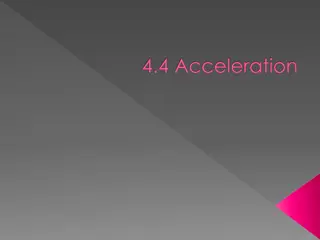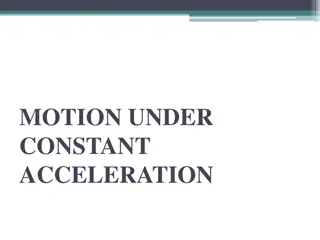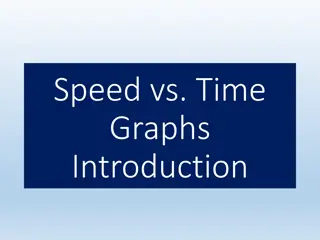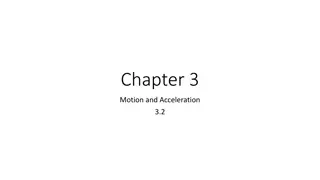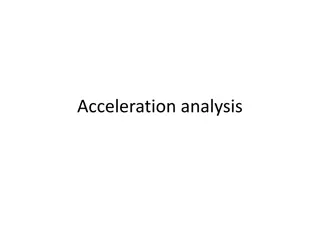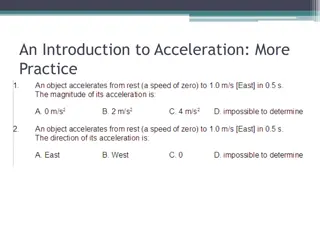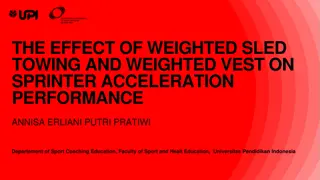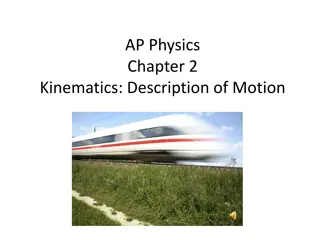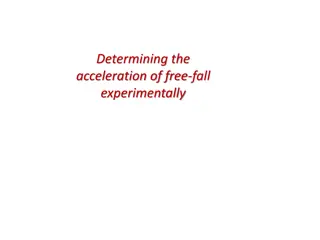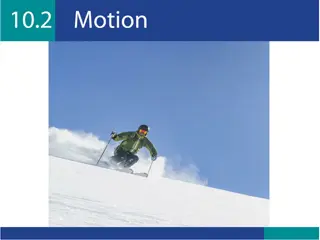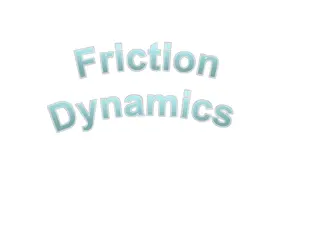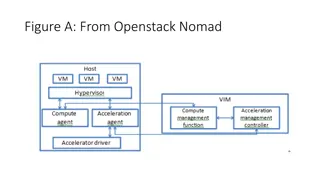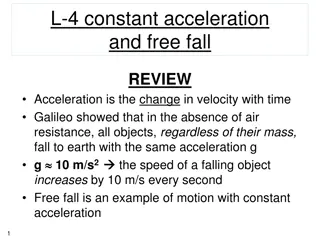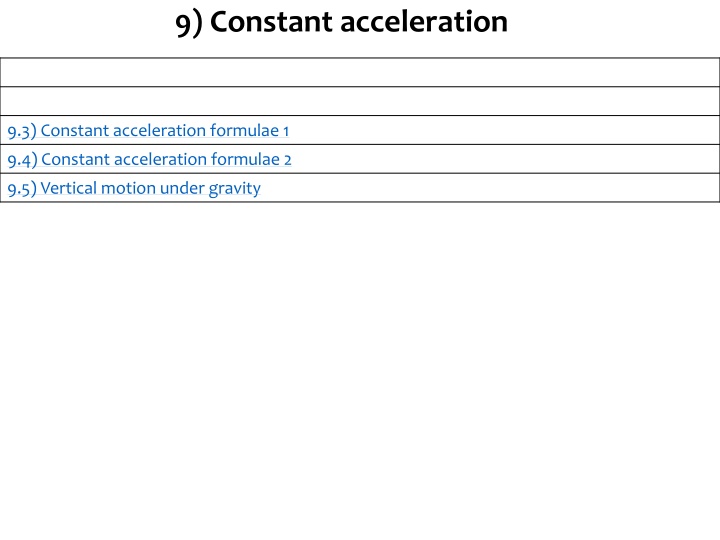
Constant Acceleration and Motion Equations
Learn about constant acceleration, motion under gravity, and how to calculate distance, acceleration, time, and velocity with worked examples. Explore chapters on acceleration formulas and derive key equations for motion.
Download Presentation

Please find below an Image/Link to download the presentation.
The content on the website is provided AS IS for your information and personal use only. It may not be sold, licensed, or shared on other websites without obtaining consent from the author. If you encounter any issues during the download, it is possible that the publisher has removed the file from their server.
You are allowed to download the files provided on this website for personal or commercial use, subject to the condition that they are used lawfully. All files are the property of their respective owners.
The content on the website is provided AS IS for your information and personal use only. It may not be sold, licensed, or shared on other websites without obtaining consent from the author.
E N D
Presentation Transcript
9) Constant acceleration 9.3) Constant acceleration formulae 1 9.4) Constant acceleration formulae 2 9.5) Vertical motion under gravity
Your turn Worked example A cyclist is travelling along a straight road. She accelerates at a constant rate from a velocity of 4 ?? 1 to a velocity of 7.5 ?? 1 in 40 seconds. Find: (a) the distance she travels in these 40 seconds (b) her acceleration in these 40 seconds. a) 230 ? b) 0.0875 ?? 2 A cyclist is travelling along a straight road. She accelerates at a constant rate from a velocity of 5 ?? 1 to a velocity of 7.4 ?? 1 in 50 seconds. Find: (a) the distance she travels in these 50 seconds (b) her acceleration in these 50 seconds.
Your turn Worked example A particle moves in a straight line from a point ? to a point ? with a constant deceleration 1.5 ?? 2. The velocity of the particle at ? is 8 ?? 1 and the velocity of the particle at B is 2 ?? 1. Find: (a) the time taken for the particle to move from ? to ?. (b) the distance from ? to ?. A particle moves in a straight line from a point ? to a point ? with a constant deceleration 3 ?? 2. The velocity of the particle at ? is 16 ?? 1 and the velocity of the particle at B is 4 ?? 1. Find: (a) the time taken for the particle to move from ? to ?. (b) the distance from ? to ?. After reaching ? the particle continues to move along the straight line with constant deceleration 1.5 ?? 2. The particle is at the point ? 6 seconds after passing through the point ?. Find: (c) the velocity of the particle at ?. (d) The distance from ? to ?. After reaching ? the particle continues to move along the straight line with constant deceleration 3 ?? 2. The particle is at the point ? 12 seconds after passing through the point ?. Find: (c) the velocity of the particle at ?. (d) The distance from ? to ?. a) 4 s b) 20 ? c) 1 ?? 1 in the direction ?? d) 21 ?
Your turn Worked example A car moves from traffic lights along a straight road with constant acceleration. The car starts from rest at the traffic lights and 30 seconds later the car passes a speed-trap where it is registered as travelling at 45 ?? 1. Find: (a) the acceleration of the car (b) the distance between the traffic lights and the speed- trap. a) 5 b) 187.5 ? A car moves from traffic lights along a straight road with constant acceleration. The car starts from rest at the traffic lights and 20 seconds later the car passes a speed-trap where it is registered as travelling at 54 ?? 1. Find: (a) the acceleration of the car (b) the distance between the traffic lights and the speed- trap. 12 ?? 2= 0.417 ?? 2 (3 sf)
Your turn Worked example ?+? ?+? Use the equations ? = ? + ?? and ? = ? to derive: Use the equations ? = ? + ?? and ? = ? to derive: 2 2 ?2= ?2+ 2?? ? = ?? +1 2??2 Shown ? = ?? 1 2??2
Your turn Worked example A particle is moving along a straight line from ? to ? with constant acceleration 5 ?? 2. The velocity of the particle is 3 ?? 1 in the direction ??. The velocity of the particle at ? is 18 ?? 1 in the same direction. Find the distance from ? to ?. 31.5 ? A particle is moving along a straight line from ? to ? with constant acceleration 3 ?? 2. The velocity of the particle is 5 ?? 1 in the direction ??. The velocity of the particle at ? is 81 ?? 1 in the same direction. Find the distance from ? to ?.
Your turn Worked example A particle is moving in a straight horizontal line with constant deceleration 4 ms-2. At time ? = 0 the particle passes through a point ? with speed 13 ms-1 travelling towards a point ?, where ?? = 20 m. Find: (a) the times when the particle passes through ? (b) the value of ? when the particle returns to ?. A particle is moving in a straight horizontal line with constant deceleration 6 ms-2. At time ? = 0 the particle passes through a point ? with speed 23 ms-1 travelling towards a point ?, where ?? = 40 m. Find: (a) the times when the particle passes through ? (b) the value of ? when the particle returns to ?. a) ? = 2.5 s, ? = 4 s b) ? = 6.5 s
Your turn Worked example A particle is moving in a straight horizontal line with constant deceleration 4 ms-2. At time ? = 0 the particle passes through a point ? with speed 13 ms-1. Find the total distance travelled by the particle between when it first passes ? and returns to ? A particle is moving in a straight horizontal line with constant deceleration 6 ms-2. At time ? = 0 the particle passes through a point ? with speed 23 ms-1. Find the total distance travelled by the particle between when it first passes ? and returns to ? 42.25 ?
Your turn Worked example Two particles ? and ? are moving along the same straight horizontal line with constant accelerations 6 and 8?? 2 respectively. At time ? = 0, ? passes through a point ? with speed 10 ?? 1. One second later ? passes through ? with speed 5 ?? 1, moving in the same direction as ?. a) Find the value of ? where the particles meet. b) Find the distance of ? from the point where the particles meet. a) ? = 13.1 s (3 sf) b) 644 m (3 sf) Two particles ? and ? are moving along the same straight horizontal line with constant accelerations 2 and 4?? 2 respectively. At time ? = 0, ? passes through a point ? with speed 12 ?? 1. One second later ? passes through ? with speed 6 ?? 1, moving in the same direction as ?. a) Find the value of ? where the particles meet. b) Find the distance of ? from the point where the particles meet.
Your turn Worked example A particle moves in a straight horizontal line with constant acceleration from A to B, then B to C. AB = 4 ?? and BC = 12 ??. It takes 2 hours from A to B and 3 hours from B to C. Find: a) The acceleration of the particle b) The particle s speed as it passes A A particle moves in a straight horizontal line with constant acceleration from A to B, then B to C. AB = 3 ?? and BC = 12 ??. It takes 2 hour from A to B and 4 hours from B to C. Find: a) The acceleration of the particle b) The particle s speed as it passes A a) 0.8 ?? 2= 6.1728 10 5 ?? 2 (3 sf) b) 1.2 ?? 1= 0.333 ?? 1 (3 sf)
Chapter CONTENTS 9.5) Vertical motion under gravity
Your turn Worked example A book falls off the top shelf of a bookcase. The shelf is 1.4 m above a wooden floor. Find: (a) the time the book takes to reach the floor, (b) the speed with which the book strikes the floor. A book falls off the top shelf of a bookcase. The shelf is 2.8 m above a wooden floor. Find: (a) the time the book takes to reach the floor, (b) the speed with which the book strikes the floor. a) 0.53 ? b) 5.2 ?? 1
Your turn Worked example A ball is projected vertically upwards, from a point ? which is 7m above the ground, with speed 21 ms- 1. Find (a) the greatest height above the ground reached by the ball, (b) the time of flight of the ball A ball is projected vertically upwards, from a point ? which is 5m above the ground, with speed 15 ms- 1. Find (a) the greatest height above the ground reached by the ball, (b) the time of flight of the ball a) 30 ? (2 sf) b) 4.6 ? (2 sf)
Your turn Worked example A ball is projected vertically upwards from ground level at a speed of 20 ms-1. Determine the amount of time the ball is at least 10m above ground level. A ball is projected vertically upwards from ground level at a speed of 40 ms-1. Determine the amount of time the ball is at least 20m above ground level. 2.9 ? (2 sf)
Your turn Worked example A ball is projected vertically upwards with initial speed of 15 ?? 1. It hits the ground 5 ? later. Find the height above the ground from which the ball was thrown. 47.5 ? A ball is projected vertically upwards with initial speed of 20 ?? 1. It hits the ground 5 ? later. Find the height above the ground from which the ball was thrown.
Your turn Worked example A stone is thrown vertically upward from a point which is 5 ? above the ground with speed 8 ?? 1. Find: a) The time of flight of the stone b) The total distance travelled by the stone a) 2.1 s (2 sf) b) 12 ? (2 sf) A stone is thrown vertically upward from a point which is 8 ? above the ground with speed 5 ?? 1. Find: a) The time of flight of the stone b) The total distance travelled by the stone
Your turn Worked example Ball ? falls vertically from rest from the top of a tower 63 ? high. At the same time as ? begins to fall, another ball ? is projected vertically upwards from the bottom of the tower with speed 21 ?? 1. The balls collide. Find the distance to the point where the balls collide from the bottom of the tower. 19 ? (2 sf) Ball ? falls vertically from rest from the top of a tower 48 ? high. At the same time as ? begins to fall, another ball ? is projected vertically upwards from the bottom of the tower with speed 24 ?? 1. The balls collide. Find the distance to the point where the balls collide from the bottom of the tower.
Your turn Worked example At time ? = 0, two balls ? and ? are projected vertically upwards. Ball ? is projected upwards with speed 2 ?? 1 from a point 50 ? above the horizontal ground. Ball ? is projected vertically upwards from the ground with speed 20 ?? 1. The balls are modelled as particles moving freely under gravity. Find the time and the height at which the balls are at the same vertical height. At time ? = 0, two balls ? and ? are projected vertically upwards. Ball ? is projected upwards with speed 3 ?? 1 from a point 40 ? above the horizontal ground. Ball ? is projected vertically upwards from the ground with speed 30 ?? 1. The balls are modelled as particles moving freely under gravity. Find the time and the height at which the balls are at the same vertical height. ? = 2.8 ? (2 sf) = 18 ? (2 sf)
Your turn Worked example A ball is released from rest at a point which is 10 ? above a wooden floor. Each time the ball strikes the floor, it rebounds with 3 which it strikes the floor. Find the greatest height above the floor reached by the ball: a) The first time it rebounds from the floor b) The second time it rebounds from the floor. A ball is released from rest at a point which is 20 ? above a wooden floor. Each time the ball strikes the floor, it rebounds with 2 which it strikes the floor. Find the greatest height above the floor reached by the ball: a) The first time it rebounds from the floor b) The second time it rebounds from the floor. 4 of the speed with 3 of the speed with a) 5.6 ? (2 sf) b) 3.2 ? (2 sf)

